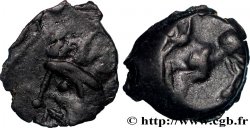Live auction - bga_344774 - GALLIA - ARVERNI (Area of Clermont-Ferrand) Statère d’or au nom de VERCINGETORIXS, type Id
You must signin and be an approved bidder to bid, LOGIN TO BID. Accounts are subject to approval and the approval process takes place within 48 hours. Do not wait until the day a sale closes to register. Clicking on "BID" constitutes acceptance of the terms of use of cgb.fr private live auctions.
Bids must be placed in whole Euro amounts only. The sale will start closing at the time stated on the item description; any bids received at the site after the closing time will not be executed. Transmission times may vary and bids could be rejected if you wait until the last second. For further information check the Live auction FAQ
All winning bids are subject to a 18% buyer’s fee.
All winning bids are subject to a 18% buyer’s fee.
| Estimate : | 50 000 € |
| Price : | 52 000 € |
| Maximum bid : | 52 000 € |
| End of the sale : | 31 March 2015 14:57:31 |
| bidders : | 3 bidders |
Type : Statère d’or au nom de VERCINGETORIXS, type Id
Date: 58-52 avant J.-C.
Metal : gold
Diameter : 18,5 mm
Orientation dies : 8 h.
Weight : 7,44 g.
Rarity : R3
Coments on the condition:
Statère parfaitement identifiable, frappé sur un flan un peu court et ovale. Faiblesse de frappe sur la partie droite de l’avers et frappe un peu confuse au revers. Le métal est régulier et semble avoir été nettoyé anciennement, avec une agréable et très fine patine. De légères traces d’écrouissage au revers. Aspect homogène avec une faible usure ; une rayure est à signaler entre les jambes avant
Catalogue references :
Predigree :
Cet exemplaire provient d’une vieille collection ; il a été acquis à la fin des années 1970, lors d’une bourse aux collections à Bressuire (Deux-Sèvres)
Obverse
Obverse legend : VE[RCIN-GETORIXS].
Obverse description : Tête nue à gauche, la chevelure ondulée ; légende commençant devant le menton, se terminant derrière la nuque ; grènetis.
Reverse
Reverse legend : ANÉPIGRAPHE.
Reverse description : Cheval bondissant à droite, un croissant au-dessus de la croupe (et une amphore entre les jambes).
Commentary
Ce statère appartient à la série monétaire gauloise la plus populaire, véritable symbole de la lutte du peuple gaulois contre l’envahisseur romain ! C’est un des rares exemple où le nom du personnage est connu par d’autres sources écrites.
Les statères de la série VERCINGETORIXS sont classés en Types ; I pour les avers à tête nue et II pour la tête casquée. Le type I se distingue selon que la chevelure est courte (Ia) ou longue (Ib, Ic et Id), selon les motifs du revers (une esse pour le type Ib et un croissant pour les type Ic (avec le cheval à gauche) et Id (avec le cheval à droite).
Notre exemplaire avec le revers à droite correspond au type Id, comme le BN. 3777. Les auteurs du Moneta recensent neuf exemplaires. Récemment, un exemplaire du même type a été vendu par S. Bourgey à 126.000€ frais compris.
Cette légende courte correspond à l’exemplaire de l’ANS provenant vraisemblablement de la collection Blancard de Marseille (cf. J.-B. Colbert-de-Beaulieu et G. Lefèvre).
Même coin de revers que le DT. 3601 D4/R3 (n° 108 du musée de Péronne).
Coin de droit proche du DT. 3600 (du musée Bargoin, associé à un revers à gauche avec l’esse).
Les statères de la série VERCINGETORIXS sont classés en Types ; I pour les avers à tête nue et II pour la tête casquée. Le type I se distingue selon que la chevelure est courte (Ia) ou longue (Ib, Ic et Id), selon les motifs du revers (une esse pour le type Ib et un croissant pour les type Ic (avec le cheval à gauche) et Id (avec le cheval à droite).
Notre exemplaire avec le revers à droite correspond au type Id, comme le BN. 3777. Les auteurs du Moneta recensent neuf exemplaires. Récemment, un exemplaire du même type a été vendu par S. Bourgey à 126.000€ frais compris.
Cette légende courte correspond à l’exemplaire de l’ANS provenant vraisemblablement de la collection Blancard de Marseille (cf. J.-B. Colbert-de-Beaulieu et G. Lefèvre).
Même coin de revers que le DT. 3601 D4/R3 (n° 108 du musée de Péronne).
Coin de droit proche du DT. 3600 (du musée Bargoin, associé à un revers à gauche avec l’esse).








 Report a mistake
Report a mistake Print the page
Print the page Share my selection
Share my selection Ask a question
Ask a question Consign / sell
Consign / sell
 Full data
Full data















